
Eurybia is a genus of plants in the composite family that were previously included in the genus Aster. Most species are native to North America, although one is also present in northern Eurasia. There are 23 species in the genus, including 1 natural hybrid. The name was first applied by Alexandre de Cassini in 1820. The name is derived from Ancient Greek εὐρύς (eurús), meaning "wide", and βαιός (baiós), meaning "few", perhaps in reference to the small number of relatively wide ray florets.

Brunfelsia pauciflora is a species of flowering plant in the family Solanaceae, the nightshades. It is endemic to Brazil, and it is grown in cultivation. A shrubby perennial plant grown in gardens, its common names include yesterday-today-and-tomorrow, morning-noon-and-night, kiss me quick, and Brazil raintree.

Ozothamnus ferrugineus, commonly known as tree everlasting, is a member of the genus Ozothamnus, of the Asteraceae family - one of the largest families of flowering plants in Australia. Native to the Australian states of New South Wales, Victoria, South Australia, and Tasmania, it forms an erect shrub or small tree between 2 and 3 metres in height.

Eulophia guineensis is a species of orchid. It is the type species of the genus Eulophia and is commonly known as the Guinea Eulophia or the broad-Leaved ground orchid. It is found in the Cape Verde Islands, much of tropical Africa and part of the Arabian Peninsula. It is a terrestrial orchid that can grow to a metre or so tall, and is found in lowland and upland woods and scrubland.
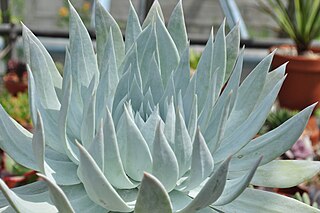
Dudleya brittonii, with the common names Britton's dudleya, Britton's liveforever and giant chalk dudleya, is a succulent plant in the family Crassulaceae. It is native to the coast of northern Baja California, Mexico. Both forms of the plant have yellow leaves on a clustered rosette atop a large reddish-purple peduncle. The white form of the plant has a chalky epicuticular wax that reflects light and reacts with water. The green form of the plant is more common and found throughout a wider range. It is among the largest of the Dudleya.
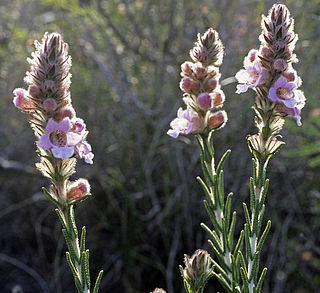
Hemiphora bartlingii, commonly known as woolly dragon, is a flowering plant in the mint family Lamiaceae and is endemic to the south-west of Western Australia. It is an erect shrub with branches covered with greyish, rusty-coloured hairs, leaves with a blistered appearance and with white, pink or purple flowers over an extended period.

Euryops brownei is a woody herb or shrub of ½–3 m (1⅔–10 ft) high, with yellow flowerheads of both ray and disc florets, and small, narrow leaves, belonging to the daisy family. The species is native to the highlands of northern Tanzania and central Kenya.

Leucadendron salignum, also known as the common sunshine conebush, is an evergreen, dioecious shrub that produces several stems from the ground of up to 2 metres high; forming part of the genus Leucadendron from the family Proteaceae. It survives the wildfires that occur every one or two decades in the fynbos where it occurs by regrowing from an underground rootstock. Pollinated by beetles, it flowers from April to November. The winged seeds remain in the woody cones until they are released after a fire, and are distributed by the wind. It is possibly the most common Proteaceae species in South Africa, and can be found in the Northern Cape, Western Cape and Eastern Cape provinces. Its current conservation status is Least Concern.

Senecio coronatus (Thunb.) Harv. aka the woolly grassland senecio is a plant in the family Asteraceae, endemic to and widespread in Southern Africa, occurring in the moister southern and eastern regions.
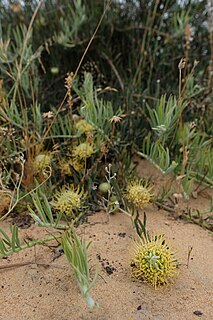
Leucospermum arenarium is a lax, evergreen shrub, with arching and drooping branches, that has been assigned to the family Proteaceae. It has loosely spaced, upright, greyish, narrowly egg-shaped to line-shaped leaves, mostly without teeth and flattened globe-shaped flower heads of 5–7 cm across, consisting of mostly creamy, seldom yellow flowers, that curve in the bud to the center of the head. From the center of the flowers emerge curved styles that jointly give the impression of a pincushion. The common name in English is Redelinghuys pincushion. It only occurs in a very small area in the Western Cape province of South Africa. It flowers between July and October. Unlike in related species the flowers are pollinated by hairy-footed gerbils and striped field mice.
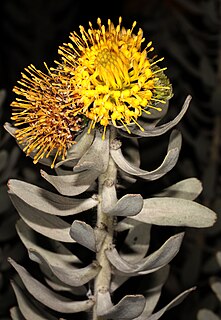
Leucospermum rodolentum is an upright, evergreen shrub of up to 3.0 m high, from the family Proteaceae. It has felty grey, elliptic to wedge-shaped leaves of 4–6½ cm (1.8–2.6 in) long and ¾–1½ cm wide, and very sweetly scented, globe-shaped, 3–3½ cm (1.2–1.4 in) wide, bright yellow flower heads, that are seated or on a very short stalk of ½ cm long, grouped with two to four together. Its common names include is sandveld pincushion in English and sandluisie or sandveldluisiesbos in Afrikaans. The plants are in bloom between August and November. It is an endemic species that only grows in a small area of the Western Cape province of South-Africa.
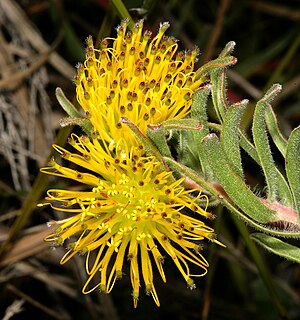
Leucospermum gracile is a low spreading shrub of 30–40 cm high and forms open mats of 1½ m (5 ft) in diameter, from the family Proteaceae. It has reddish flowering stems, oblong to linear leaves of 2–4½ cm (0.8–1.8 in) long and 2–5 mm (0.08–0.20 in) wide, with one or three teeth. The initially yellow, later orange flower heads of 2½–3 cm (1.0–1.2 in) in diameter are flat-topped. The flower heads occur from July to October. From the flowers occur long styles with a slightly thicker tip, which together give the impression of a pincushion. It is called Hermanus pincushion in English. It naturally occurs in fynbos in the southern mountains of the Western Cape province of South Africa.

Helichrysum somalense, commonly known as dwarf everlasting, is a rosette herb from the family Asteraceae. It is endemic to Tasmania, where it is commonly found in the West and Southwest of the island state. It is distinctive by its inflorescence, with the flower stalk being densely matted in fine white hairs and the daisy-like flower head having numerous pink or white ray floret-like bracts.

Symphyotrichum racemosum is a species of flowering plant native to parts of the United States and introduced in Canada. It is known as smooth white oldfield aster and small white aster. It is a perennial, herbaceous plant in the family Asteraceae. It is a late-summer and fall blooming flower.

Helichrysum calvertianum is a species of flowering plant in the family Asteraceae. It is a small subshrub with small crowded leaves and single white daisy-like flowers. It is endemic to the Southern Highlands in New South Wales.

Verbesina centroboyacana is a species of shrub in the daisy family endemic to Colombia.
Jeffreycia is a genus of African flowering plants in the daisy family. They are in the Vernonieae subtribe.
Ozothamnus tesselatus, commonly known as tesselate everlasting, is a flowering plant in the family Asteraceae. It is a small shrub with woolly branches and globular heads of whitish to straw-coloured flowers.

Gazania pectinata, the cockscomb Gazania, is a species of calendula native to the lower-lying regions and coastal plains of the Western Cape Province, South Africa.

Gazania rigida is one of the flowers known as a calendula, native to the Western Cape and Northern Cape Provinces of South Africa.




















